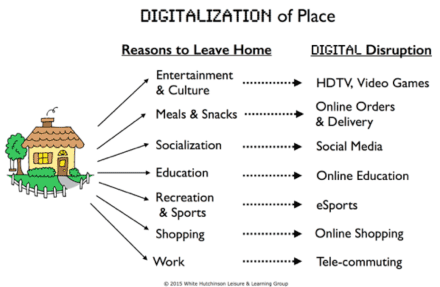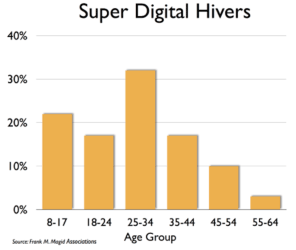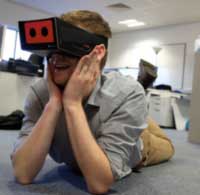
Vol. XV, No. 2, February-March 2015
- Editor's travelogue & more
- Vietnam's largest FEC opens
- How much Americans love pizza
- Real live escape game venues continue to multiply
- Under-the-radar bar trend
- Announcing Foundations Entertainment University 2.0
- How to boost your posts on Facebook
- National survey results for participation in FEC activities
- The power of live events
- Free scholarships to Birthday University, April 2
- The full scoop on market & financial feasibility studies
- Nationwide laser tag participation survey results to be revealed at Laser Tag Convention
- The rise of super Digital Hiving
- The no vacation trend continues
- IRS changes rules on automatic group tips
The rise of super Digital Hiving
Back in 1991, trend expert Faith Popcorn first identified the Cocooning trend where consumers disconnected from the world by retreating to their homes as a safe haven for comfort, safety and enjoyment. 9/11 exacerbated the Cocooning trend. The home became the cave from which people increasing viewed the outside world rather then venture out into it.
People are now re-conceptualizing their homes away from the idea of being a somewhat depressing protective sanctuary to being a fun place of social connectivity, a focal place of activity, welcoming in family and friends and expressing their creativity through entertainment and hospitality. Home is becoming the best place to reestablish relationships and connect with others, whether by bringing them into our homes or digitally having elationships with them on social media. The Cassandra Report reported that in an October 2014 national survey of 18- to 34-year-old device-owning Millennials found that almost one-third (31%) now feel that “digital relationships are just as meaningful as in-person relationships.” This new evolved trend is called Hiving or Home Central. Once stuck at home, now we can't wait to get there. Home is the command central for this new expanding lifestyle.
What perhaps more than anything else has enabled and helped drive growth of Hiving is the arrival and widespread adoption of increasing advanced digital technology with increasing bandwidth 24/7 Internet connectivity. As a result Hiving is undergoing a metamorphosis to what we might call Super Digital Hiving, Digital Hiving on steroids.
We used to regularly leave home to visit places, whether it was to shop, attend university classes, eat at restaurants or enjoy entertainment and cultural events with our friends. The Internet and digital technology is slowly digitizing all those experiences. Home has become a place where everything we need is within reach. We have no reason to leave our homes in order to conduct our business or our lives. We can just hive in the safe comfort of our homes without the hassle of getting dressed and driving somewhere. Rather, we can now experience the equivalents of most real world experiences in the digital world or use the digital world to have them delivered to our home. And that is exactly what people are increasingly doing, Super Digital Hiving.

Super Digital Hivers spend twice as much on home entertainment than does the typical American with an Internet connection. Of that spending, their spending on video games is more than 3.5 times typical and on home video, 2.5 times typical.

Continued advances in digital technology and connectivity are sure to drive the growth of this stay-at-home mindset into the future. Internet connection speeds are becoming super fast (we now have one gigabit up and down speeds in our office for the very affordable price of $100 per month from Google Fiber. In Kansas City it's available for homes for only $70 per month). The quality for our digital devices is going up. Game consoles are becoming super advanced. The quality of the game content is going up. Gamers are now all connected on Xbox live. Televisions are increasing in size and quality, including resolutions to 4K and higher. We have increasing amounts of premium media content we can enjoy on our TVs or other screens, much of it instantaneously streamable. We can socialize with our friends anywhere in the world while we watch TV doing the two-screen thing, conversing with each other while watching. It's all very social although we are each in different homes.

And on the horizon is affordable virtual reality for the masses. Headsets available today cost in the hundreds of dollars. VISR in the UK is launching a virtual reality headset that will retail for around $30. The headset will be smartphone-compatible for either Android or iOS, meaning users can insert their existing smartphones into the headset and enjoy an immersive experience.
And when it comes to actually bringing your friends into your home, digital technology is facilitating that so it can be real world customized Digital Hiving event. You can send a message to your friends to meet up, ask what type food they want, send them movies choices to vote on to watch on Netflix or Amazon Prime. Then you can order in the food from the restaurant or restaurants of choice and you all can then enjoy a fun communal experience. It's far easier, more convenient and far less expensive than meeting up at a restaurant and then taking in a show at the cinema.
Super Digital Hiving has serious implications for any located-based business, including entertainment venues. No matter what out-of-home activity data our company has analyzed, with rare exception, they all show a continued trend since the early 2000s of decreasing participation and visits. Visits to real world places of all types are on the decline. This includes shopping, visits to restaurants, to all types of entertainment and out-of-home leisure or to just visit some location to socialize. People are leaving their homes increasingly less often.
People are spending less time in out-of-home leisure experiences. Between 2004 and 2013, average annual time spent attending out-of-home arts and entertainment venues was down by one-fifth (-20%) and average annual time spent attending sporting events was down by one-quarter (-25%).
And spending on digital technology is on the increase to enable Digital Hiving experiences, including having real world things from the outside world delivered to our homes. Between 2004 and 2013, average household inflation-adjusted spending on digital equipment and technology, including computers (for non-business use), audio-visual and cellular phone equipment, services and subscriptions increased by almost one-third (31%) while average household spending on out-of-home entertainment and culture declined by one-quarter (-27%). In 2013, average household spending on digital equipment and technology had grown to fourteen times the spending on fees and admissions for out-of-home entertainment and culture.
To counter this growing stay-at-home mindset to stay in our Digital Hives, location-based businesses need to offer experiences that are unachievable@home and unachievable on our screens. And to get people to leave their hives, those experiences need to be premium, great quality, what we call High Fidelity. What that means is the out-of-home experience has to:
- Have a very high perceived value, both in terms of the leisure time and the discretionary dollars expended
- In most situations, be very social and communal
- Have a prestige, a cachet that creates social capital
- Be worth sharing somehow on social media
And what may seem counterintuitive is that if the experience is really High Fidelity, the segment of the population with sufficient discretionary incomes to come, are actually willing to pay a premium price for it.
P.S. There can be little doubt that digital hiving is resulting in the decline in taking vacations. Check out our article in this issue: The no vacation trend continues. LINK
Vol. XV, No. 2, February-March 2015
- Editor's travelogue & more
- Vietnam's largest FEC opens
- How much Americans love pizza
- Real live escape game venues continue to multiply
- Under-the-radar bar trend
- Announcing Foundations Entertainment University 2.0
- How to boost your posts on Facebook
- National survey results for participation in FEC activities
- The power of live events
- Free scholarships to Birthday University, April 2
- The full scoop on market & financial feasibility studies
- Nationwide laser tag participation survey results to be revealed at Laser Tag Convention
- The rise of super Digital Hiving
- The no vacation trend continues
- IRS changes rules on automatic group tips


